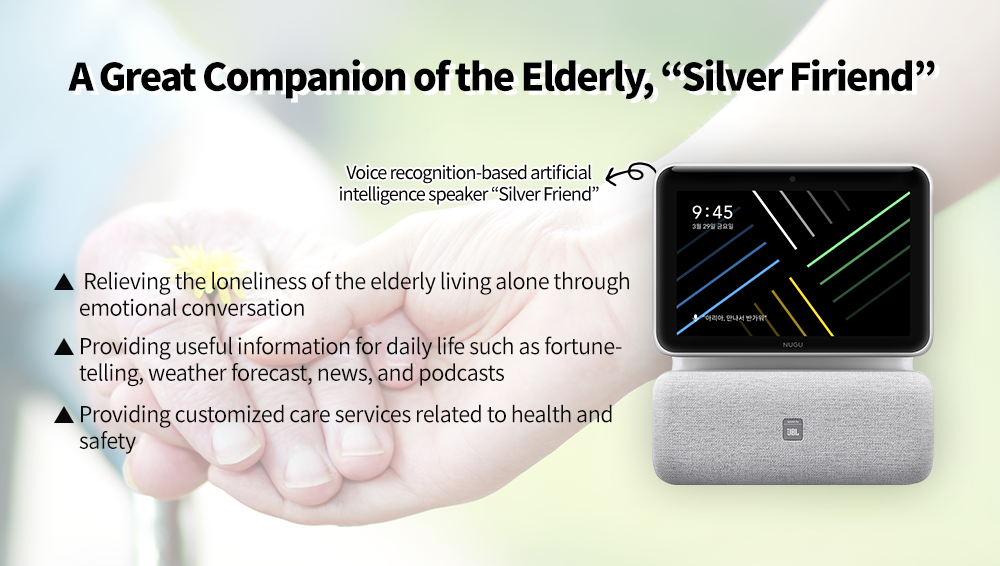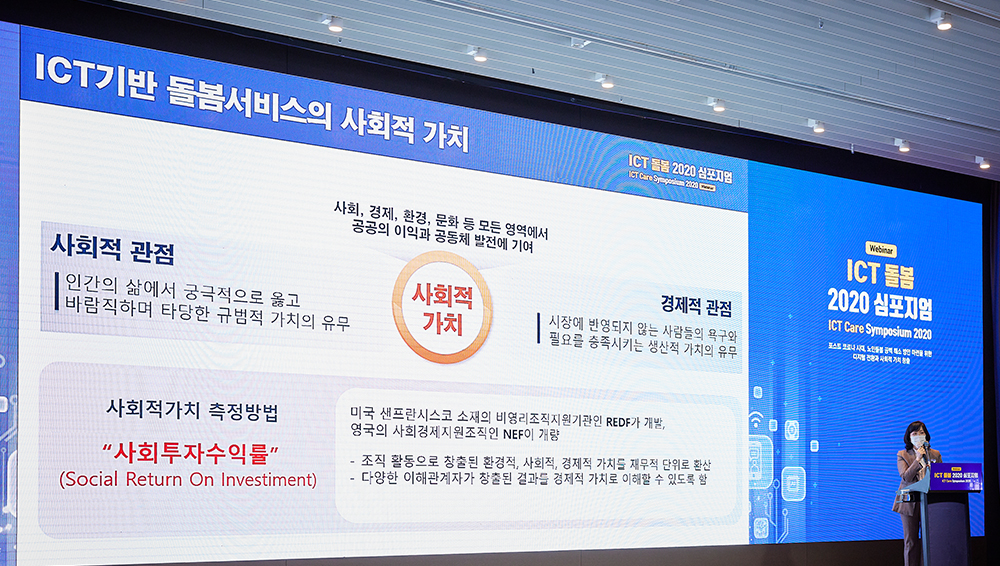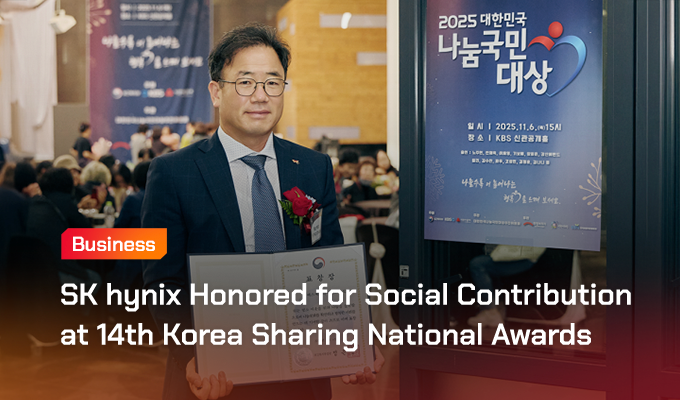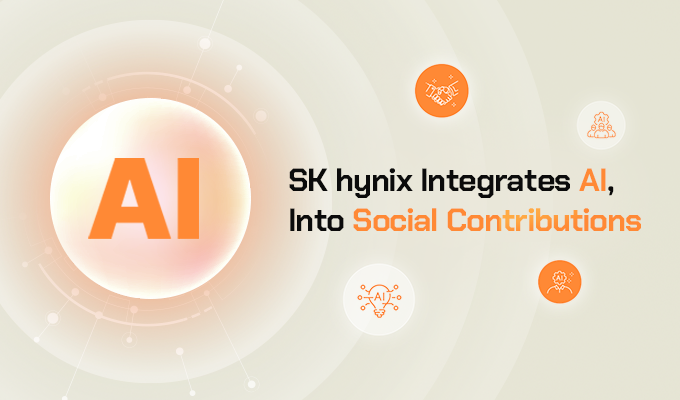With the continuous spread of COVID-19, the social and economic isolation of the vulnerable, including the elderly living alone in particular, is emerging as a social problem. This is because the elderly in need of help are more left unvisited, as the risk of infection makes it difficult for home visit care services to be done. This can lead to more serious social problems, such as an increase in the number of deaths of the elderly living alone, so-called “solitary death”. For this reason, interest in the smart care services which enable real-time contact-free care based on information and communication technology (ICT), is increasing.
Among these smart care services, SK hynix’s ICT care service for social contribution called “Silver Friend” is emerging as an exemplary case of the elderly care model in the COVID-19 era. After being invited to a seminar held by the United Nations Economic and Social Commission for Asia and the Pacific (ESCAP), it was introduced as an excellent case at the “ICT Care Symposium 2020” where domestic and foreign experts in the elderly welfare field gathered together.
Through the two events, the SK hynix newsroom team analyzed the reasons why Silver Friend is attracting attention globally, as an excellent case of the digital transformation of elderly care services.

SK hynix’s “Silver Friend” is Globally Recognized for Its Good Influence
In 2015, the UN adopted 17 United Nations – Sustainable Development Goals (UN-SDGs)1 through the 70th Summit. With these goals, the UN has been making various efforts with the international community to solve the universal social, economic, and environmental problems.

17 Sustainable Development Goals set at the 70th United Nations (UN)
General Assembly in 2015 (Source: United Nations official website)
One of such efforts is responding to the rapid aging of the population, especially in the Asia-Pacific region, and the resulting health inequality for the elderly. The UN ESCAP forecasts that the number of seniors aged 60 or over in the Asia-Pacific region will double from the estimated 630 million in 2020 to 1.3 billion in 20502. In particular, the outbreak of the COVID-19, which is showing signs of being prolonged, is raising concerns that such an increase in the elderly population may lead to an increase of the blind spots in the medical field for the vulnerable.
With these concerns, the international community is now paying more attention to the smart care industry that can replace the face-to-face care services, with an aim for achieving the goals of “Good Health and Well-Being (SDG3)” and “Reduced Inequalities (SDG10)”. The smart care industry is to build a sustainable social care infrastructure even during the pandemic by using artificial intelligence (AI) computers and humanoid robots.
A web seminar (webinar) hosted jointly by the UN ESCAP and the Ministry of Health and Welfare of Korea, held on November 4th in Bangkok, Thailand, also corresponds to this context. This webinar themed “Using ICT to promote and enhance accessibility and quality of health and long-term care of older persons” was to discuss different ways to improve accessibility and quality of medical services of the elderly in the Asia-Pacific region in the COVID-19 era by reviewing the best practices that solved the healthcare problems of the elderly by utilizing ICT.

Keynote by Hong-Geun Jeong, Director-General of the International Cooperation Bureau,
Ministry of Health and Welfare, at a webinar “UN ESCAP ICT Care” held on November 4
In particular, the UN ESCAP selected SK hynix’s Silver Friend as a best practice and invited Yong Kun Park, Head of CR Strategy at SK hynix as a special speaker for the webinar’s second session, “Information and communication technologies for active aging based on findings and implications of the studies”.
In the special speech, Yong Kun Park introduced Silver Friend as a “high-tech care service model for the elderly” that relieves the loneliness of seniors living alone, through the convergence of online and offline technologies.
“Korea is one of the countries that are aging the fastest. The elderly living alone face many different dangers such as loneliness and poverty, but the existing public and private support systems have limitations in caring for them. The Silver Friend program planned and operated by SK hynix provides an emotional-friendly AI device through cooperation with government agencies including the Ministry of Health and Welfare, Comprehensive Support Center for the Elderly Living Alone, and the National Fire Agency. Through this, the Silver Friend program aims to establish an ICT-based support system that can immediately improve the lives of the elderly living alone. In fact, Silver Friend is faithfully performing the role of a great life partner for the elderly by improving problems related to loneliness and inconvenience in the daily lives of the elderly. Also, the device usage data are transmitted in real-time to the elderly care base station and the National Fire Agency, contributing to effective emergency response.
“Silver Friend Effect” Measured by Economic Value Attracts Attention from Domestic and Overseas Welfare Experts
On the same day, another event to discuss the importance of ICT care was held in Korea. Hosted by the Comprehensive Support Center for the Elderly Living Alone and sponsored by the Ministry of Health and Welfare, SK hynix, Community Chest of Korea, and the International Society for Gerontechnology (ISG), “ICT Care Symposium 2020” was held.
The symposium was held in two divisions, starting with a keynote speech by robot engineer and professor of Mechanical & Aerospace Engineering Dennis Hong who developed the humanoid robot “Dynamic Anthropomorphic Robot with Intelligence-Open Platform (DARwin-OP)”.
The first division themed with the “Current Status and Tasks of the ICT Care” introduced major domestic and overseas ICT care service cases and related research results through sessions including the following: △ Research and development of intelligent (smart) care in the public sector (by In-hyuk Moon, Member of Social System Innovation Sub-Committee of the Presidential Committee on the Fourth Industrial Revolution); △ ICT-based care service models in the domestic social welfare field (by Hyun Mi Kim, General Manager of Comprehensive Support Center for the Elderly Living Alone); and △ Overseas ICT care trends (by Espen H. Aspenes, Vice President of ISG).
The second division themed with the “Domestic and Overseas ICT Technology Demonstration Cases” included presentation sessions as follows: △ Wearable robot for improving the body strength (by Jae-ho Jang, CEO of Field Robot Technology (FRT) Co., Ltd.; △ Care service for the elderly using sensors and Internet of Things (IoT) (by Deok-young Jung, Deputy Director of the Seongnam Senior Experience Complex); △ Digital healthcare using big data (by Thomas Linner, Scientific Director of the “EU Reach 2020” Project; and △ Smartphone education to support information accessibility (by Thomas Kamber, CEO of Senior Planet).

A presentation by Hyun Mi Kim, General Manager of Comprehensive Support
Center for the Elderly Living Alone, at “ICT Care Symposium 2020”
In particular, Hyun Mi Kim, General Manager of the Comprehensive Support Center for the Elderly Living Alone who gave the second presentation of the first division, introduced SK hynix’s Silver Friend as an exemplary model that embodies the “essential elements for the elderly care service in the COVID-19 era”. The three essential elements she introduced during her presentation include the following: △ Self-care: Improving the ability of the elderly to manage their lives on their own; △ Social well-tech: Resolving the digital information gap of the elderly through the convergence of social welfare services (offline) and ICT technology (online); and △ Providing various customized content to relive loneliness due to the restrictions on the face-to-face services.
During the presentation on that day, Silver Friend’s social return on investment (SROI)3 index and the amount of the social value created were announced as well, attracting a lot of attention. SROI is a concept where the notion of “social” is added to a company’s return on investment (ROI). In other words, it is a methodology that combines and quantitatively measures social and economic values created by social enterprises or non-profit organizations. By measuring the ratio of the created social value per invested currency unit, the invisible social value can be converted into a concept such as money, allowing various stakeholders including companies to easily understand the value.

According to the results of research4 sponsored by the Comprehensive Support Center for the Elderly Living Alone and conducted by the Social Value Institute, the SROI index of the Silver Friend Is 5.085. This suggests that the social value of KRW 12.6 billion was incurred for the elderly living alone, SK hynix volunteers, life support workers, local governments (Icheon and Cheongju), stakeholders of the National Health Insurance Service, etc., when comparing to the investment cost of KRW 2.48 billion. In other words, this shows that it has created more than five times the value per won invested in Silver Friends.
With regards to this, Sung-ki Bae, Director of the Social Value Institute talked about the background of carrying out this research by saying, “SROI is the conversion of the social value of an organization into currency units. It is a measurement methodology widely used in many countries worldwide including the UK, which is interested in creating social value at the government level by preparing various related systems and policies. With this methodology, it is possible to verify the performance of care services like Silver Friend, which cannot be easily evaluated in terms of financial performance, in a relatively objective way.”
General Manager Hyun Mi Kim, “Silver Friend is the Best Case of Solving Community Problems with Corporate Technology”
The Silver Friend project which started in September 2018 has reached its third year this year. A total of around 2,800 devices have been distributed to the elderly living alone through 42 nationwide organizations executing the Customized Care Services for Older Adults. How has the daily life of the elderly changed? The newsroom team met Hyun Mi Kim, General Manager of the Comprehensive Support Center for the Elderly Living Alone, and heard about how the life of the elderly has changed after using Silver Friend and what efforts are needed to activate the program further.

Hyun Mi Kim, General Manager of Comprehensive Support Center for the Elderly Living Alone
Silver Friend monitors the health status and emergency situations of the elderly in real-time, in connection with the 42 nationwide organizations executing the Customized Care Services for Older Adults. Whenever Silver Friend is activated, usage records are accumulated as data to identify the behavioral patterns of the elderly.
Especially, the “Doran Doran News” function that delivers essential health and life information remotely serves as a communication channel between the elderly and life support workers. In fact, it proved itself to be very helpful when the 5-day Rotation System for Purchasing Mask was implemented nationwide at the early stage of the COVID-19 outbreak. Through the “Doran Doran News” function, life support workers could send a message to the elderly who are confused about purchasing masks in order to remind them of the day of the purchase so that they could buy masks on time by themselves.
General Manager Hyun Mi Kim said, “Silver Friend is a very useful service in that it can deliver information that cannot be easily grasped through TV news channels, from the perspective of the elderly.” Also, various types of entertainment content such as music streaming services, fortune-telling services, weather forecast, podcasts, and recipes are provided. The “emotional conversation” function that enables mutual communication by learning language patterns through deep learning is also a unique feature of this device. General Manager Kim said, “For many seniors, Silver Friend is a ‘friend’ or a ‘companion robot’.” She added, “Above all, it is a smart care suitable for the COVID-19 era in that it helps the elderly live their own daily lives without relying on institutions or life support workers.”
As the project is planned to be significantly expanded in terms of the support target scope to include multicultural families and the disabled, some points need to be improved at the social and institutional level. One of them is to reduce telecommunication costs caused by installing devices and using the Internet. General Manager Kim said, “It is necessary to establish supplementary measures to reduce the cost burden of the vulnerable, such as expanding the installation of public Wi-Fi and subsidizing telecommunication expenses in the form of vouchers.” She also said, “The performance of the device will be enhanced as well so that personalized exercising support services or customized medical services such as consultations can be provided.”

Hyun Mi Kim, General Manager of Comprehensive Support Center for the Elderly Living Alone
“I think that there is a role of a company essential for society to develop for a better future. From that point of view, I think that SK hynix’s Silver Friend is a case where the spirit of ‘social value’ is well practiced by using advanced technology, which is an asset of a company, to solve local and social problems. As we have been for the last three years, the Comprehensive Support Center for the Elderly Living Alone will work hard to help more seniors living alone live a happy and comfortable life through continuous cooperation with SK hynix.”
1 United Nations-Sustainable Development Goals (UN-SDGs): The largest joint goals between the United Nations and the international community implemented from 2016 to 2030, after ending the Millennium Development Goals (MDGs), implanted from 2000 to 2015. It aims to address universal issues of humanity (poverty, disease, education, gender equality, refugees, conflict, etc.), global environmental issues (climate change, energy, environmental pollution, water, biodiversity, etc.), and economic and social issues (technology, housing, labor, employment, production and consumption, social structure, law, domestic and foreign economy, etc.), through 17 goals and 169 targets.
2 Source: Official website of the UN ESCAP, < Webinar on “Using ICT to promote and enhance accessibility and quality of health and long-term care of older persons”>
3 A measurement methodology developed by San Francisco based Roberts Enterprise Development Fund (REDF), a non-profit organization support institution with the mission of creating jobs and providing job opportunities, and then improved by the New Economics Foundation (NEF), a social economy support organization in the UK.
4 , June 2020, Social Value Institute Social Value Institute
5 The SROI index is calculated by dividing the “social value added”, which is calculated through subtracting the “social cost” from the “social benefit”, by “investment cost” (SROI=net present value of social benefits / net present value of social costs). The research process for extracting each element applied to the formula includes the following six steps to minimize the intervention of subjective judgement elements: △ Stakeholder analysis; △ Mapping outcomes; △ Establishing value; △ Evaluating impact; △ Calculating the SROI; and △Verification.











